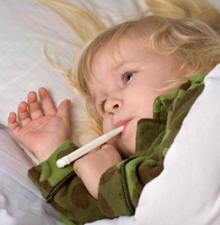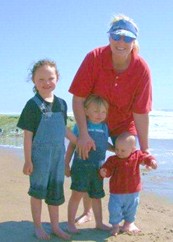Toddler Fever

While toddler fever is a common symptom in children, many parents find any rise in their child’s temperature alarming. In reality, the fever that accompanies a bacterial or viral infection is a blessing, not a curse. It occurs because of the spontaneous release of pyrogens, our body’s natural defense mechanism for fighting disease. The presence of fever tells you that your child’s repair mechanisms have gone into high gear.
Important note: In order for you to find this article by doing a Google Search for “Toddler Fever”, we had to write it in such a way that both humans and search engines could find it. As a result, when we refer to fever in this article we will call it “toddler fever”, even though the information applies to all fevers unless otherwise noted.
How Parents Have Been Taught to Fear Toddler Fever
Many parents have been taught to fear fevers by the medical profession. How? Because of the typical pediatric practice of asking what a child’s temperature is when a parent calls to report that their child is sick.
While temperature does offer a diagnostic clue when it comes to assessing a sick child, toddler fever in and of itself is not a cause for concern. Unfortunately, because of the medical profession’s fixation on it, they have mistakenly caused parents to fear fever and worst yet to have the misconception that the height of the body temperature is an indication of the severity of the illness.
In reality, some illnesses like Roseola (one-day measles) produce extremely high temperatures while other more serious diseases may not produce any temperature at all. The height of fever is not a measure of the severity of an illness. Fever is the body’s natural defense against infection and is an indication that the process of healing is speeding up. It is something to rejoice over, not to fear as we will discuss next.
What Toddler Fever Really Means
As already stated, the presence of toddler fever tells you that your child’s repair mechanisms have gone into high gear. The process works like this. When your child contracts an infection, his body responds by manufacturing additional white blood cells called Leucocytes. They destroy bacteria and viruses and remove damaged tissue and other irritating materials from the body.
When your child’s temperature rises it causes the activity of white blood cells to increase so that they move more quickly to the site of the infection. This part of the process is called Leucotaxis, and was stimulated by the release of the pyrogens that raised your child’s body temperature. Net, net, the presence of fever is an indication that your child’s healing process is speeding up. This is something to rejoice over, not fear.

Toddler fever in and of itself is not a cause for alarm. Animal studies have demonstrated that the death rate among animals with disease decreases when the body temperature is elevated. Unless your child’s fever unusually high (over 106 degrees) or is accompanied by additional symptoms such as vomiting or respiratory difficulties it is better to let it run its course.
So instead of fixating on your thermometer, pay attention to the overall appearance, behavior and attitude of your child. That will be a better indication of how sick he really is. Also pay attention to external factors that may be causing the fever like poisoning, exposure to toxic substances or over exertion in the heat (heatstroke).
When Toddler Fever Really is a Cause for Alarm
If your toddler develops a high fever and you suspect outside causes may be causing it, do be concerned. If you suspect your child has swallowed poison or over-exerted himself in the hot sun, rush him to a hospital emergency room. If poisoning or toxic exposure is suspected, bring the container or information about the substance with you so that they antidote can be quickly identified.
Most of the toddler fevers that spell serious trouble are the result of poisoning, exposure to toxic substances, or caused by over exertion in the hot sun. Temperatures of 107 degrees or above resulting from these causes can result in lasting bodily harm. Children can rapidly become overheated in a sauna or hot tub, so it is a good idea to ensure you children don’t go into these environments.
If your child collapse or lapses into unconsciousness, even briefly, after strenuous activity in the hot sun or over exposure in a sauna or hot tub, take him to the hospital emergency room at once. Why? Because EXTERNAL influences can be very dangerous because they can overwhelm your child’s bodily defenses that prevent temperatures from soaring to dangerous levels.
YOU, not your pediatrician, are the best judge of normal versus abnormal behavior in your children. The best way to judge whether or not your child is in trouble is not taking his temperature. You can judge much more accurately by the appearance and behavior of your child. Extreme and abnormal behavior such as extreme listlessness, confusion, respiratory difficulty, and uncontrollable vomiting are all indications that you should see your doctor.
This article is about toddler fever, but you should know that a fever of any level in a newborn baby thru the first few months of life is reason to immediately see you doctor. If you are breastfeeding, this is likely something that you are extremely unlikely to experience since your baby will be receiving antibodies from you that will protect it from infection making it much less likely your baby will get sick, much less run a fever.
What To Do When Your Child Has a Toddler Fever
Remember, the toddler fever is helping your child heal. If your child is not presenting any of the above mentioned alarming symptoms, it is best to let it run its course. Do nothing unless the toddler fever persists for more than three days or other symptoms develop, or your child looks and acts really sick. In that event, see your doctor, preferably a holistic doctor.
For a great book about raising a healthy child as well as an entire chapter on fever, buy “How to Raise a Healthy Child” by Robert S. Mendelsohn, MD.
Make sure your child is getting 8 oz of water every hour to prevent dehydration. If your child is running a fever, he will need additional fluids to replace those he is losing by sweating coughing, having diarrhea, a runny nose, vomiting and breathing rapidly. Although any fluids will do, those that are easy to digest, provide electrolytes and have some nutritional value are best.
Our favorites fluids for treating toddler fever are plain water with a pinch of natural sea salt for the electrolytes, banana milk made by blending a banana with raw milk, and chicken broth. Chicken Broth is great since it provides electrolytes as well as gelatin to settle queasy stomachs. Warning: it must be homemade chicken broth since canned varieties are full of MSG often labeled as “natural flavors” or “natural spices”.
What NOT to do when your child has a toddler fever
Don’t try to lower your child’s temperature with aspirin or acetaminophen. Don’t try to lower your child’s temperature with a sponge baths. Just let the fever run its course while providing your child lots of love and extra fluids.
Ensure your child eats a healthy diet. Avoid foods and drinks with lots of sugar as sugar can interfere with immune response (white blood cells) for up to 6 hours after consumption. For more information about this read Suicide by Sugar by Nancy Appleton, PhD.

I can’t just sit by while my child suffers! you may say, but remember, while reducing your child’s fever may make him more comfortable, you will be interfering with the natural healing process if you do it. As a parent, your first priority should be your child’s long term health, not immediate comfort.
We know! It’s hard being a parent and having to watch what your child has to go thru to develop a strong, healthy immune system… Again research has shown that the death rate of animals infected with disease is higher when their body temperature is lowered.
In one study during a measles epidemic in Ghana, Africa, children were divided into two groups. One group received antipyretics (fever reducers, such as aspirin) -- typical at many hospitals. Mortality was five times greater than in the group that did not receive this treatment.
In another study conducted in Afghanistan, 200 children with measles were divided into two groups. Once again, members of one group received aspirin to lower fever. The study revealed that children receiving the antipyretics had prolonged illness, more diarrhea, ear infections and respiratory ailments, such as pneumonia, bronchitis and laryngitis, and significantly greater mortality rates.
Studies demonstrating Fever Reducers Result in Increased Complication Rates and Mortality:
- Witsenburg, B.C. "Measles mortality and therapy," pp. 26-27. From an abstract of a 1967-1968 measles epidemic study conducted in Ghana.
- Ahmady, A.S., et al. "The adverse effects of antipyretics in measles." Indian Pediatrics (January 1981), pp. 49-52.
Excellent Sources of Additional Reading
How to Raise a Healthy Child in Spite of Your Doctor
By Robert S. Mendelsohn M.D.
Dr. Robert Mendelsohn, renowned pediatrician and author advises parents on home treatment and diagnosis of colds and flus, childhood illnesses, vision and hearing problems, allergies, and more. PLUS, a complete section on picking the right doctor for your child, step-by-step instructions for knowing when to call a doctor, and much more.
Super Healthy Kids: Strengthening Your Child's Resistance to Disease
by Jane Sheppard
Super Healthy Kids gives you valuable information on what you can do to strengthen your child's immune system to prevent disease and create increased vibrant health and vitality. It covers food and nutrition, supplements and herbs for building healthy immunity.
Super Healthy Kids tells you how to avoid exposing your child to toxic substances. It gives you reliable information about antibiotics and vaccines and how they can weaken your child's immunity. Included is a section on preventing and dealing with allergies and another section on easily integrating healthy immunity-building into your family's lifestyle.
Nourishing Traditions: The Cookbook that Challenges Politically Correct Nutrition and the Diet Dictocrats
by Sally Fallon with Mary Enig
An excellent theoretical and practical book about nutrition and cooking, with over 700 recipes. As the authors say, "a fascinating guide to wise food choices and proper preparation techniques" recalling the culinary customs of our ancestors.
This is the book we can wholeheartedly recommend for family nutrition.Child Health Guide: Holistic Pediatrics for Parents
by Randall Neustaedter OMD, LAc
Child Health Guide: Holistic Pediatrics for Parents, by Randall Neustaedter OMD, LAc is the first accessible, reliable, and complete medical manual on holistic pediatrics and natural treatment for children. Dr. Neustaedter provides the information parents need to integrate natural treatments into their children's medical care. He incorporates the philosophies of attachment parenting and holistic medical care, and offers practical solutions to the problems that all parents face.
Preventive medicine is a cornerstone of natural health care, and this book empowers parents by giving them the tools to maintain their child's vibrant good health. The book also discusses holistic treatments for acute, recurrent, and chronic childhood illnesses.
Parents can trust the Child Health Guide as a safe, effective resource for creating their children's path to optimal health, from infancy through the teen years.
Smart Medicine for a Healthier Child
by Janet Zand
Written by a natural-medicine practitioner (Janet Zand) , a traditionally licensed doctor (Robert Rountree), and a pediatric nurse (Rachel Walton), Smart Medicine for a Healthier Child presents an integrated approach to children's health care that allows a parent to do just that.
This excellent reference applies a full spectrum of responses to common childhood health problems: conventional medical treatments, dietary guidelines, nutritional supplements, herbal treatments, homeopathy, and acupressure; for each ailment, general recommendations and preventive measures are also offered.








New! Facebook Comments
Tell us what you think!